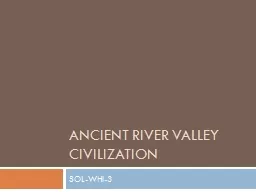

SOLWHI3 The 1 st River Valley Civilizations During the New Stone Age permanent settlements appeared in river valleys and around the Fertile Crescent River Valleys provided water and rich soil for crops as well as protection from invasion ID: 413599
Download Presentation The PPT/PDF document "Ancient River Valley Civilization" is the property of its rightful owner. Permission is granted to download and print the materials on this web site for personal, non-commercial use only, and to display it on your personal computer provided you do not modify the materials and that you retain all copyright notices contained in the materials. By downloading content from our website, you accept the terms of this agreement.
Slide1
Ancient River Valley Civilization
SOL-WHI-3Slide2
The 1st
River Valley Civilizations
During the New Stone Age, permanent settlements appeared in river valleys and around the Fertile Crescent.
River Valleys provided water and rich soil for crops as well as protection from invasion. Identify the location of the earliest river valley civilizations (about 3500 to 500 b.c. [b.c.e.]), using the following information as a guide: M______________ civilization: Tigris and Euphrates River Valleys (Southwest Asia) E_____________ civilization: Nile River Valley and Nile Delta (Africa) I_______________ civilization: Indus River Valley (South Asia) C civilization: Huang He Valley (East Asia)Slide3
The 1
st
River Valley Civilizations Cont..
River valleys offered rich soil and irrigation water for agriculture, and they tended to be in locations easily protected from invasion by nomadic peoples.Division of l____________Complex s_______ institutions (e.g., for religion, government)Advanced t__________C_________W_______ l___________What is the final step in the establishment of a civilization? WRITTEN LANGUAGEWhat characteristics do the four ancient river valley civilizations have in common? Slide4
Early Written Language
1. Pictographs
2. Sumerian C__________-
3. Egyptian- H__________-(Rosetta Stone)4. Phoenician- A__________- Slide5
River Valley Civilizations Time Line of Events
• Mesopotamia: Sumerians,
Akkadians
, Babylonians, Hittites, Assyrians, Chaldeans• Egypt: Old, Middle, and New Kingdoms; shifts in power; causes for different kingdoms• Indus River: Establishment, height, cause for collapse• Huang He (Yellow River): Mythic beginnings, Shang, ZhouSlide6
River Valley Civilizations influenced Social, Political, and Economic Progress
T
he
development of social patterns of ancient river valley civilizations:• Hereditary rulers: Dynasties of kings, pharaohs • Rigid class system where slavery was accepted
Development
of political patterns of ancient river valley civilizations, using the following information as a guide:
World’s
first states (i.e., city-states, kingdoms, empires)
Centralized
government, often based on religious authority
Written
law codes (e.g.,
T____ C_________,
Code of
H__________)Slide7
Land of Canaan
River Valleys offered rich soil and irrigation water for agriculture, and they tended to be in locations easily protected from invasion by nomadic peoples.
Identify other early civilizations (about 2000 to 500
b.c. [b.c.e.]), using the following information as a guide:H____________ settled between the Mediterranean Sea and the Jordan River Valley (part of Fertile Crescent in Southwest Asia). P______________ settled along the Mediterranean coast (part of Fertile Crescent in Southwest Asia). N______________ was located on the upper (southern) Nile River (Africa).Slide8
The Ancient Hebrews
Location-South Western Fertile Crescent
C_________
(later Israel)Significance-Worlds 1st M__________ Religion: JudaismBelief in Y_______ (Hebrew name for God)Believed to be “God’s C________ People”Founder: A______ (later A__________)Slide9
Abraham
Where did Abraham and his family originally come from? Where did they go?Slide10
The Torah
The first
___
books of the Hebrew Bible.
The most sacred
text in the Jewish
religious tradition.
God’s covenantSlide11
Migration to Egypt
According to the Bible, many Hebrews had gone down
into Egypt
because there was a famine in Canaan and they had no food. Instead of returning home to Canaan, they stayed in EgyptSlide12
Moses
After more than 400 years of
slavery, in
the early 1200's B.C., Moses was born.Although an Israelite, Moses was raised in the pharaoh's household. This pharaoh was probably Ramses II. According to the Torah,God asked Moses to ask the Pharaoh to let the Israelites leave Egypt. Pharaoh refused!God gave Moses miraculous powers, including the ability to cause outbreaks of disease and destruction called plagues.Slide13
Exodus
Each time a plague happened,
Pharoah
promised to let the Israelites go, but each time he changed his mind.Finally, according to the Torah,
a plague came
in
which
the first-born child of all the
Egyptians
died
- even
Pharoah's
son. After this terrible
plague,
Pharoah
finally let the
Israelites leave Egypt.Slide14
Phoenicians
Achievement #1:Extraordinary shipbuilders and sailors
Government:City-States
Sidon and Tyre made red-purple dye (60,000 snails made one 1 lb. brick) Byblos traded papyrus.Greatest colony was Carthage (Tyre)Slide15
Phoenician Trade Routes
Round-hulled ships
Goods:
Murex (purple dye)GlassLebanon cedarSlide16
Phoenician AlphabetSlide17
Egyptian River Valley Civilization